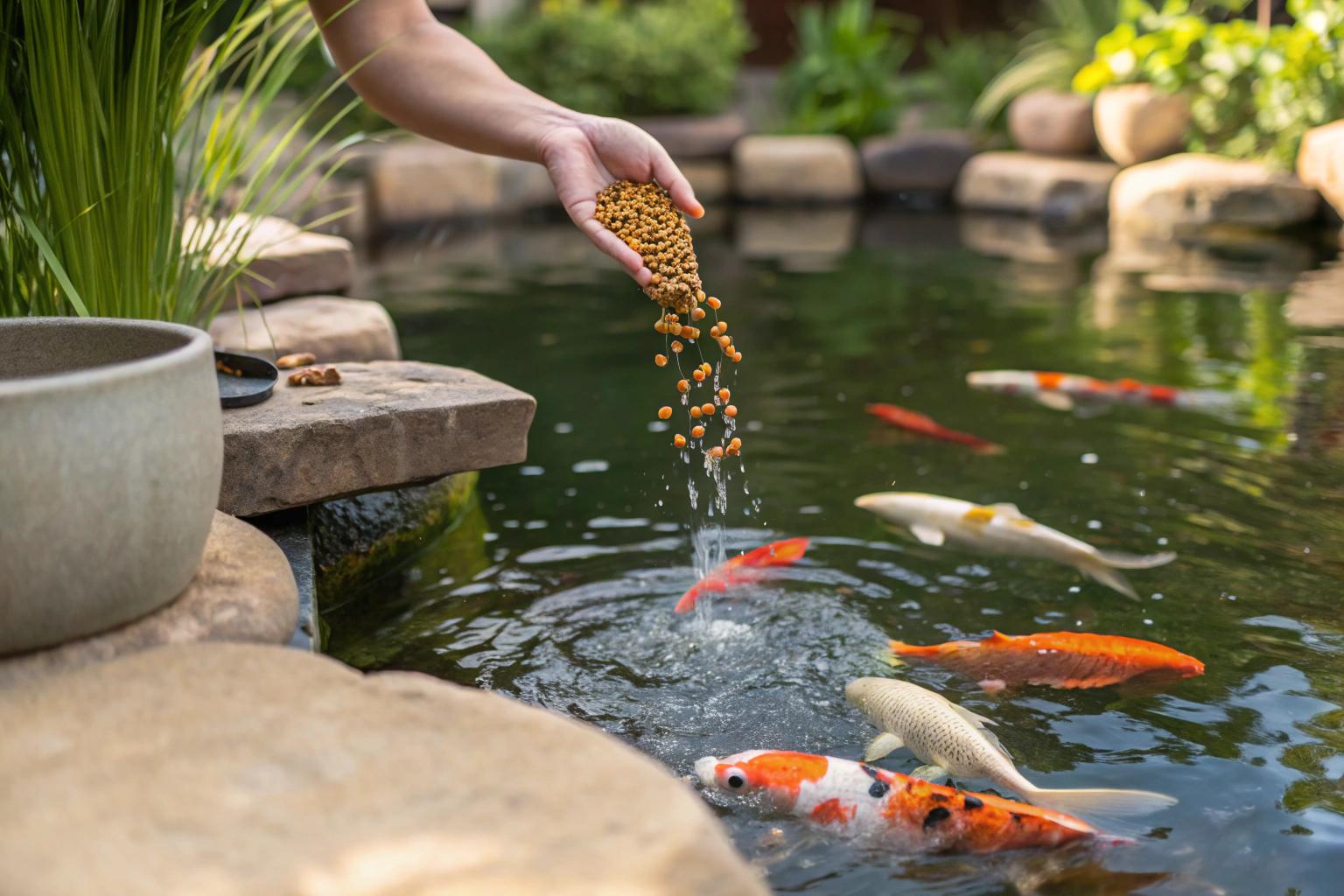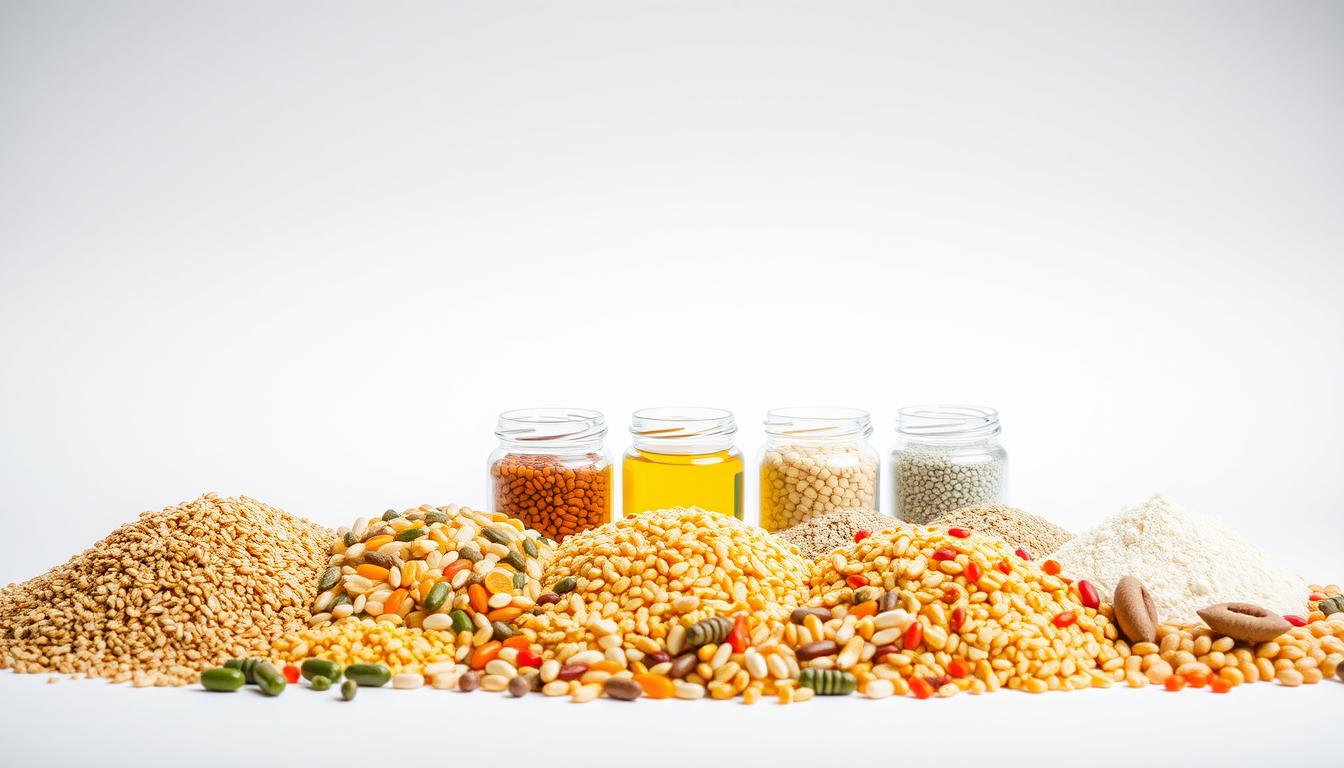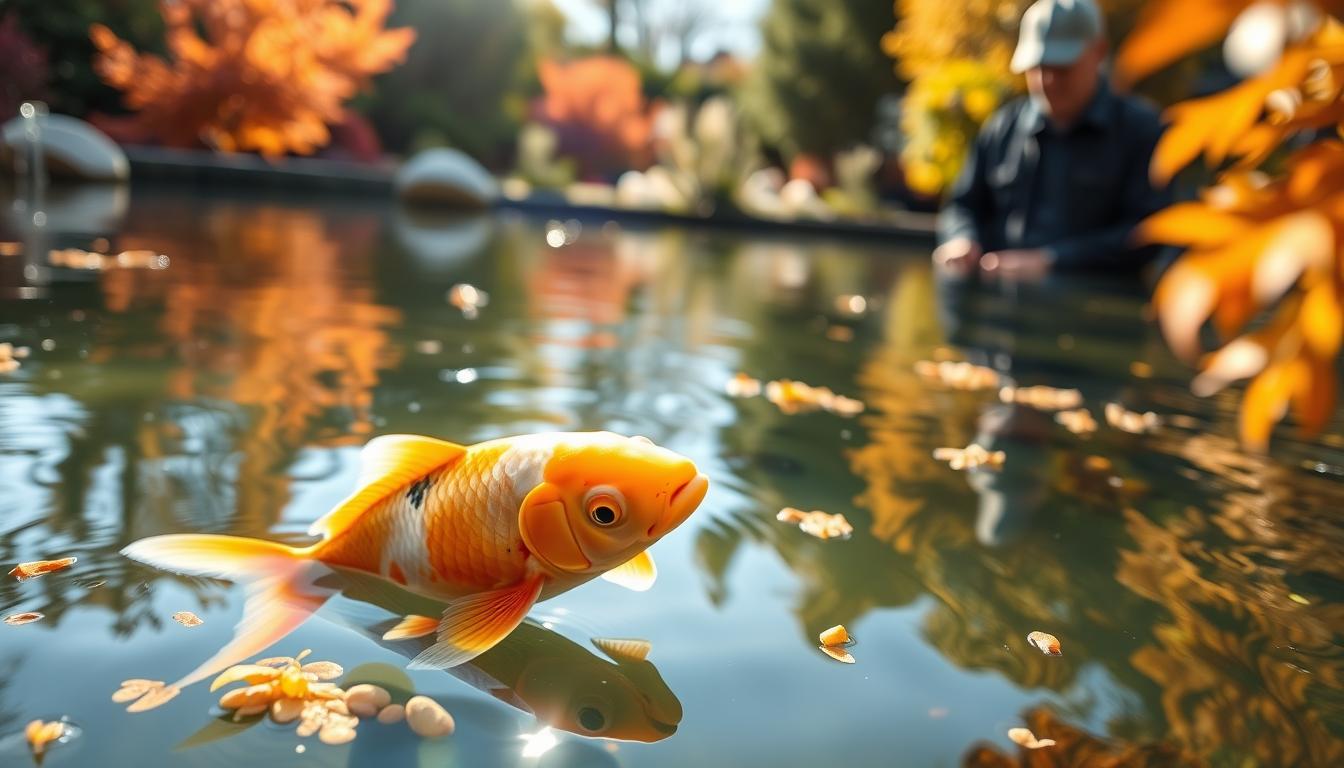Are Expensive Koi Fish Foods Really Worth the Extra Cost for Better Health?
This post may contain affiliate links.

Did you know that 70% of pond owners overspend on specialty diets without understanding their actual benefits? Premium options like Mazuri® Koi Premium Food promise vibrant colors and robust health, but is the investment justified? This article dives into the science behind high-end nutrition and what it truly means for your aquatic companions.
Experts emphasize that quality ingredients—like those in Mazuri® formulas—directly impact immune support and growth rates. However, feeding frequency and seasonal needs matter just as much as the price tag. Studies show that even well-balanced mid-range diets can deliver results when paired with proper pond care.
We’ll break down how to evaluate protein sources, vitamin blends, and feeding schedules. You’ll also learn why some enthusiasts swear by premium brands while others prioritize budget-friendly staples. Whether you’re raising show-quality specimens or simply passionate about your pond’s ecosystem, clarity awaits.
Key Takeaways
- High-cost diets aren’t always better—ingredient analysis is critical.
- Feeding frequency (like multiple times per day) affects nutrient absorption.
- Seasonal adjustments optimize health year-round.
- Color-enhancing formulas rely on specific nutrients, not just pricing.
- Expert-recommended brands balance quality and affordability.
Introduction to Koi Fish Health and Feeding Fundamentals
Creating a thriving pond ecosystem starts with understanding what your aquatic friends require to flourish. These colorful swimmers thrive on variety—commercial pellets, fresh greens, and freeze-dried treats all play roles in their diet. How you feed them matters just as much as what you offer, with schedules shaping digestion and vitality.
Did you know their metabolism speeds up in warmer water? Feed them multiple times per day during summer but reduce portions when temperatures drop. This rhythm prevents waste buildup while meeting energy demands. Ingredients like wheat germ shine here—they’re packed with vitamins that boost immunity and enhance natural hues.
Three pillars define smart feeding:
- Consistent timing (2-4 times per day in active seasons)
- Diverse protein and plant sources
- Adjustments for weather changes
High-quality blends often include wheat germ or spirulina, but even budget options work when balanced. Upcoming sections will compare floating vs. sinking pellets and reveal how temperature guides portion sizes. Ready to unlock a routine that keeps your pond lively? Let’s dive deeper!
Understanding the Nutritional Needs of Your Koi
A balanced diet fuels more than just growth—it’s the cornerstone of vitality for pond dwellers. Proteins build muscle and repair tissues, while vitamins like C and E strengthen immune systems. Minerals such as calcium support bone development, especially in younger specimens. Color intensity often hinges on carotenoids found in ingredients like spirulina, proving that vibrant hues start from within.
Key Nutrients and Dietary Requirements
Aquatic pets thrive when meals include 30-40% protein during active seasons. Lipids provide energy, but excess fats can cloud water quality. Fiber-rich plants aid digestion, reducing waste buildup. For aging swimmers, lower-protein options prevent strain on slower metabolisms.
How Water Temperature Influences Metabolism
Warmer ponds (68-75°F) speed up digestion, requiring frequent, energy-dense feedings. Below 50°F, their systems slow dramatically—think of it as hibernation mode. Overfeeding in cool conditions risks uneaten meals rotting and disrupting pH balance. Adjust portions seasonally, using wheat germ-based blends when temperatures dip.
But nutrition isn’t just about what’s in the pellets—it’s also about when and how much you offer. Testing ammonia levels weekly helps tailor routines. Remember: clear water reflects thoughtful feeding as much as premium ingredients do.
Exploring Different Types of Koi Food
Variety isn’t just the spice of life—it’s essential for a balanced aquatic diet. From fresh greens to specialized pellets, each option offers unique benefits tailored to different needs. Let’s break down the choices to help you craft a meal plan that keeps your pond vibrant.

Fresh, Freeze-Dried, and Prepared Options
Fresh treats like chopped veggies or shrimp provide natural protein and vitamins, but they spoil quickly. Freeze-dried alternatives retain nutrients longer and are perfect for occasional boosts. Prepared pellets, however, deliver consistent balanced nutrition with ingredients like wheat germ to support immunity year-round.
Enthusiasts often mix these options. One hobbyist shared, “I use pellets daily but add freeze-dried daphnia weekly for extra protein.” This approach ensures variety without compromising water quality.
Floating versus Sinking Pellets
Floating varieties let you monitor feeding activity, reducing waste. They’re ideal for warmer months when metabolism peaks. Sinking pellets suit cooler temperatures or shy eaters, as they mimic natural foraging. Both types can include high-quality protein sources like soybean meal or krill.
Key takeaway? Rotate between formats based on season and behavior. A blend of floating and sinking options keeps meals engaging while meeting dietary needs.
Selecting the Best Koi Fish Food for Your Pond
Smart feeding starts with decoding what’s inside the bag. Labels reveal more than marketing claims—they’re your roadmap to balanced nutrition. Focus on first-listed ingredients, which make up the largest portions. Whole proteins like shrimp meal or algae should dominate, not vague terms like “fish derivatives.”

Evaluating Ingredient Quality and Benefits
Particle size matters more than you think. Smaller grains (under 3mm) suit younger pond dwellers, while larger pellets prevent waste in mature populations. Look for wheat germ in cold-weather blends—it’s easier to digest when temperatures drop.
Vitamins A and C aren’t just buzzwords. These compounds enhance natural coloration and shield against infections. One study found specimens fed spirulina-rich diets developed 23% brighter hues within eight weeks.
Balancing Cost with Nutritional Value
Premium brands often charge for specialized formulas, but mid-range options can work wonders. Compare protein percentages across price tiers—a 35% blend at $25 might outperform a 40% option costing twice as much.
- Buy in bulk during spring sales for summer feeding peaks
- Store sealed bags in cool, dry places to preserve freshness
- Mix high-quality staples with seasonal supplements
Remember: consistency beats occasional splurges. A steady diet of vitamin-packed pellets given 3-4 times per day trumps erratic gourmet feedings every time.
Feeding Guidelines: Times, Portions, and Best Practices

Timing and quantity are the twin pillars of effective feeding strategies. Aquatic pets thrive on consistency—like clockwork meals that match their metabolic needs without overwhelming their environment. Start by offering small portions multiple times daily, but always watch how quickly they clear their plates.
Optimal Feeding Frequency and Duration
Most enthusiasts find success with 2-3 feedings per day during active months. Each session should last no longer than five minutes—any leftovers risk sinking and fueling algae blooms. “If they’re still nibbling after five minutes, you’re giving too much,” advises pond expert Linda Carter.
Adjustments matter throughout the year:
- Summer: 3-4 daily feedings (water temps above 68°F)
- Spring/Fall: 1-2 lighter meals
- Winter: Skip feeding below 50°F
Observe behavior during meals. Active surface feeding signals proper portions, while disinterest may mean overfeeding. One Ohio pond owner reduced algae issues by 40% simply by switching to timed feedings with a kitchen timer.
Remember: those five minutes per session aren’t arbitrary. Studies show 90% of nutrients get consumed within this window, keeping water cleaner. For stubborn algae problems, pair portion control with weekly pond vacuuming to remove hidden debris.
Seasonal Strategies for Koi Dietary Adjustments

Water temperature acts like a metabolic thermostat for pond inhabitants. When mercury rises above 68°F, their systems kick into high gear—perfect for protein-rich meals that fuel growth and vibrant hues. Cooler temperatures below 50°F signal time to simplify menus for slower digestion.
Spring and Summer: Boosting Protein and Lipids
Warmer months call for energy-dense nutrition. Aim for 35-40% protein blends with added lipids from sources like krill or mealworms. Many enthusiasts report success with live insects tossed near the surface, where active swimmers eagerly snatch them.
An Arizona pond owner shares: “I mix high-protein pellets with dried shrimp during peak summer. My community goldfish show brighter colors within weeks.” This approach supports both growth and natural foraging behaviors.
Fall and Winter: Transitioning to Easily Digestible Foods
As days shorten, switch to wheat germ-based formulas that break down quickly in cooler water. These prevent digestive strain while maintaining energy levels. Reduce portions to once daily when temperatures dip below 55°F.
Watch for these signs during seasonal shifts:
- Increased surface activity in spring
- Slower consumption rates in autumn
- Goldfish companions seeking sheltered areas first
One Minnesota hobbyist stabilizes autumn diets by blending seasonal veggies with sinking pellets. “My aquatic crew still gets nutrients without taxing their systems,” they note. Regular appetite checks ensure smooth transitions between feeding regimes.
Monitoring Water Quality and Wellbeing
Crystal-clear water isn’t just about aesthetics—it’s a lifeline for your pond’s inhabitants. Regular testing for ammonia, nitrites, and pH levels acts like a wellness checkup, catching issues before they escalate. Overfeeding ranks as the #1 cause of water degradation, according to aquatic retailers’ data from 2023.
Preventing Overfeeding and Pollution
Uneaten meals break down rapidly, releasing harmful compounds that strain filtration systems. This process depletes oxygen, creating stress for swimmers. A simple rule? If it’s not eaten in five minutes, it’s too much.
Practical steps to maintain balance:
- Test water weekly with kits designed for ponds
- Scoop leftovers using fine nets within 15 minutes
- Rotate between floating and sinking options to reduce residue
Fresh freeze-dried choices like daphnia leave minimal waste compared to some pellets. One Michigan hobbyist shared: “Switching to quick-dissolve treats cut my filter cleanings by half.” Pair portion control with surface skimmers to tackle debris proactively.
Remember: clear water reflects smart habits as much as premium products. By aligning feeding routines with filtration capacity, you create a self-sustaining environment where vibrant colors and active behaviors thrive naturally.
Expert Tips for Successful Koi Feeding and Health
A well-timed feeding schedule does more than fill bellies—it builds trust between caretakers and aquatic life. Consistency helps pond inhabitants recognize their provider, encouraging natural behaviors and reducing stress. Let’s explore how routines and observation create thriving ecosystems.
Establishing a Consistent Feeding Routine
Serve meals at the same times daily, ideally during peak activity periods like mid-morning or late afternoon. This predictability supports digestion and strengthens bonds. One enthusiast noted, “My group swims to the same spot every day at 10 AM—they’ve learned the rhythm.”
Monitor oxygen levels during feedings, especially in summer. Aerate the water beforehand to boost metabolism. For variety, add freeze-dried brine shrimp twice weekly. These protein-packed treats mimic natural prey without clouding the water.
Recognizing Behavioral Cues
Active surface splashing often signals hunger, while lethargy may indicate overfeeding or poor water quality. Watch for rapid gill movements—a sign of oxygen depletion during digestion. Adjust portions if leftovers linger beyond five minutes.
Seasonal shifts require flexibility. In spring, increase portions gradually as temperatures rise. During autumn cooling, switch to smaller, wheat-based meals. One Michigan caretaker shares: “Noticing slower eating in fall prompted me to adjust schedules—health improved within weeks.”
Remember: keen appetites reflect wellness. Pair routines with weekly oxygen level checks to maintain harmony. Your attention to detail ensures vibrant colors and energetic behaviors year-round.
Conclusion
Nourishing your aquatic companions requires more than just tossing pellets into the water—it’s about strategic choices and attentive care. High-quality ingredients fuel vibrant colors and strong immune systems, but how you feed matters as much as what’s in the mix. Seasonal shifts demand adjustments: protein-rich meals for summer energy and wheat germ blends when water temperatures drop.
Make sure to prioritize water quality by testing weekly and removing uneaten food promptly. Observing behavior—like surface activity or slower eating—helps tailor routines. Your koi goldfish need consistency, whether it’s timed feedings or rotating between floating and sinking options.
Remember: balanced diets paired with smart practices create thriving ecosystems. Implement expert tips like gradual portion changes and temperature-based schedules. By staying alert to koi goldfish needs and water temperatures, you’ll foster a lively pond where health shines through every ripple.
Ready to transform your approach? Start today—your aquatic friends will thank you with dazzling displays and energetic antics!
